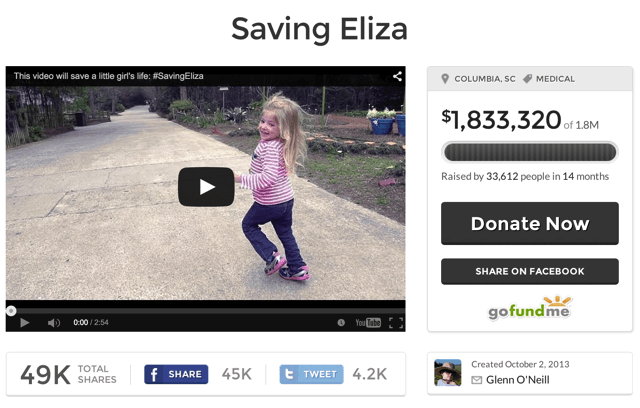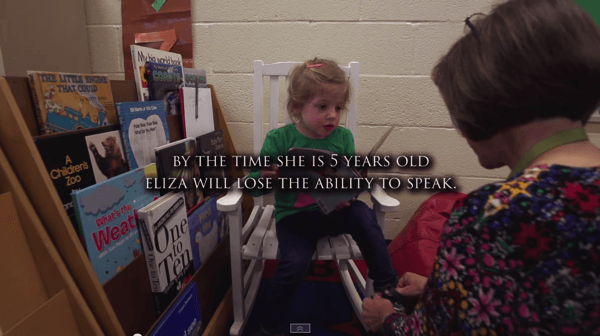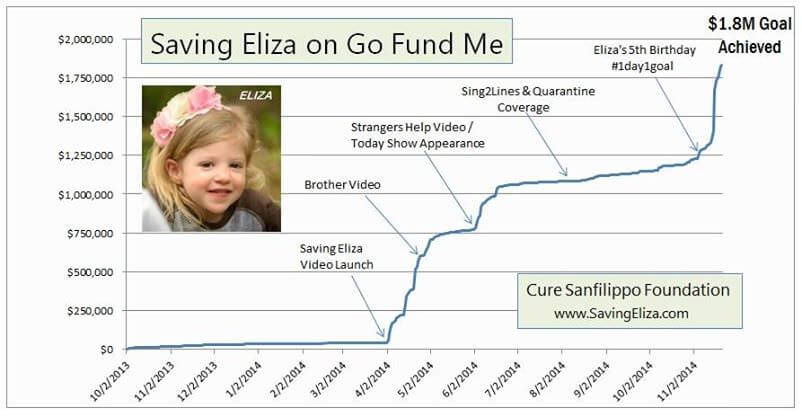Earlier this year, I made a video that went viral. This video — created to help fund a cure for a complex degenerative brain disease that 4-year-old Eliza O’Neill and thousands of others suffer from — took a flagging GoFundMe campaign that had only managed to raise $96,000 over 9 months and helped it to raise $900,000 in 2 months.

Renewed efforts to raise enough to fund the clinical trail in full ultimately led to the campaign raising another $800,000 over the next 6 months, shattering the all time GoFundMe record by over a million dollars… and all this because a stranger from the other side of the world decided to fly himself over and make a miracle video.
As a result of the campaign’s incredible success, desperate calls and emails began streaming in asking me to make miracle videos for a variety of different causes and situations:
There’s just one problem: as crucial a piece of the puzzle as the Saving Eliza video was, it wasn’t a miracle. The true heroes of this story are Eliza’s parents, Glenn & Cara. It was their unwavering commitment in the face of seemingly impossible odds, not my simple video, that made the entire campaign a success.
Feeling utterly powerless in the face of all these pleas for help that I would never be able to properly answer, I decided to write something that will, I hope, empower these families to set up their own miracle stories. This is that post.
1. Tell a good story
By “story,” I don’t mean “lie.” I mean presentation. People don’t know who you are, and they probably don’t care much about you yet. People have their own busy lives to worry about, and you are going to interrupt their routine. Make sure that when you do, it’s with a spectacular story.
-
Select a target audience and connect with them
Depending on who you’re attempting to reach, things should be packaged differently. Are you talking to parents or teenagers? The Internet generation or the mainstream media? People who are religious or not? These factors will change how you frame your story.
Ideally, you’re trying to target the audience that is most likely to be moved to action by your cause.
Not sure which audience to target? Target the category that you belong to. Chances are good you already speak their language, and speaking the right language enables you to connect to people that you’ve never met before.
-
Define the problem and keep it simple.
People are busy and don’t care about the nitty gritty details. They want to know what’s happening and why they should care in as short an amount of time as possible.
Reserve the details for the footnotes where the detail-oriented and curious can dive deeper… strip the main message down to the bare essentials for everybody else.
Answer three critical questions:
- Who are you?
- What do you want to do?
- Why do you want to do it?
-
Outline the solution
The world is broken. We all know it. Everywhere you look, someone needs help, something needs fixing, so why should anyone care about you?
The truth is everyone wants to make a difference. And though the problems in this world are vast and numerous, it’s rare that we’re actually offered a chance to make a difference… the difference… for someone. Make sure that, whatever your cause is, you empower each and every viewer with the power to make that difference. Give them a chance to be part of something bigger than themselves.
-
Have a simple call to action
Once people are engaged, don’t loose them. The process of giving should be dead simple: Cheque, PayPal, credit card, money order – make the process as simple as possible and address every possible giving outlet.
Not all crowd funding sites are created equal. Do your research and make sure to check the fine print on transaction fees. Find the right service for you that hits your target demographic.
Purchase a simple domain name and have it forward straight to your fundraising page. More memorable, more official, more shareable.
Don’t want to take my word for it? Read this media creation firm’s deconstruction of what made the Saving Eliza video a success: http://www.portnoymediagroup.com/2014/04/15/saving-eliza/

2. Do your homework
There are no shortcuts. The secret to success is a lot of failure, a lot of trail and error, and a lot of hard work. The O’Neills’ continuous tenacity to save their daughter regardless of how insurmountable the odds is what made the campaign a success. The fact that they had never organized a fundraiser prior to Eliza becoming sick was just another obstacle to overcome.
-
Research the cause
Whatever the cause, become an expert in everything that relates to your situation. From the Internet to the library, you should take advantage of every resource at your disposal and find out everything there is to know about the cause you’re trying to raise money for.
People will question you just as often as they offer potential solutions, and you will need to know how to reply to them quickly and accurately. Back up your answers with links to reputable sources in the same way a journalist would. Question everything you read on the Internet and compile all the information you find into a comprehensive document that you can reference when the time comes.
If you are hoping for any type of mainstream news coverage, be sure that your story stands up to proper journalism standards.
-
Research how to spread your story
Connect with other individuals and organizations that have gone through a similar journey and ask them for tips, tricks and contacts. If you went through Step 1 and built a proper storyline, you can use that to start building a list of people that you can reach out to for support and help spreading your message once you’re ready.
Ask every single friend you know for media contacts — radio, television, Internet, journalists, blogs, independent writers, religious entities, non-profits — everybody knows somebody. Save them up, learn about them, and plan your “sales pitch”.
Read: “How to make a viral video”
by viral video consultant Karen X. Cheng.
-
Research fundraising options
From golf tournaments, corporate events, bake sales and dance-a-thons to viral videos, there are a plethora of different fundraising ideas you can come up with.
These activities create valuable social media updates and multimedia content that can be shared across all the networks that you will be reaching out through. Additionally, people are more likely to stand behind you if you are being proactive.
Need more concrete fundraising tips? Glenn highly recommends these books:
- Jab, Jab, Jab, Right Hook: How to Tell Your Story in a Noisy Social World
by Gary Vaynerchuk
- The Fundraiser’s Guide to Irresistible Communications
by Jeff Brooks
- Philanthropy in a Flat World
by Jon Duschinsky
- The Generosity Network
by Jennifer McCrea and Jeffrey Walker

3. Be shareable
You have a story, you have all the supporting contacts waiting to seed out the story, now you need to provide them with the ammunition to spread the news to the world. Make sure to find your brand name and then stick to it. Your website and social handles should all match. Once it’s created, it’s very hard to change so make sure it works across all platforms before you commit!
-
Start your social media empire
Begin registering, managing and populating social media with your story. Register a Facebook Page, Twitter, YouTube, Vine, and Instagram. It might feel overwhelming at first, but each channel serves a different purpose. If you don’t know where to start, my advice is to Start Anywhere.
My top three:
- Facebook Page: A place to make official announcements, friendly to longer texts, photos and videos, and easy to share with people of any generation, companies of any size and sympathetic causes.
- Twitter: 140 characters, small updates, simple photos that are easy for people to re-tweet. Enables you to easily reach out and connect with companies and corporations.
- YouTube: Vidfeos empower you to transport people right into your story — update and share any fundraising events you go to, interviews that you do, or campaigns that you are currently running.
-
Create compelling multimedia content
Chances are you’re not a professional photographer or videographer; the good news is that you don’t really need to be. Do you have a smartphone? Start using it to tell a story.
Try to capture the real human moments. This is your chance to connect with people who don’t know who you are, who don’t know your story. You have to give them a reason to care.
Be relatable. Be strong. Be vulnerable. All at the same time.
There is a time and place for professional photos and videos. A lot of the time, lower quality content can make you more relatable.
That being said, I would highly recommend having at least one professional photo session for press kits, media promotion, etc. ready to go.
I would also highly recommend a short, professionally filmed video that tells your story. Regardless if it’s a story covered by a news station or one you put together yourself for the Internet, one very strong piece can make a big difference.
Find someone good. Find someone local. It’s worth the investment.
-
Create ways for people to get engaged
Assuming you’ve done things well thus far, chances are you’ve had offers from complete strangers reaching out to you, offering to help however they can. Make sure you have something for them to do. T-shirts, press kits, banners, competitions… whatever.
If no one’s come knocking yet, don’t be shy about reaching out to organizations around you (grassroots organizations, schools, churches, businesses, etc.) Being able to harness the power of your local community will train and prepare you for the national attention to come.

4. Never give up
Not everyone will support you. It will be exhausting, and some days it’ll feel like nothing you do is making a difference.
But guess what? It can’t be worst than sitting around doing nothing.
The only thing people see are the success stories — how $620,000 was raised in 15 days for Eliza’s 5th Birthday Campaign — but no one remembers the 4 months of agonizing silence and failed strategies that pre-empted it.
No one remembers the false hopes from corporations that reached out offering to fund the campaign in full and then going silent. No one remembers the National TV Shows that told us they wanted to feature the story, then postponed it over and over again before canceling outright because “something else came up.”
For every success there are tens and often hundreds of failures, rejection letters, and crushing disappointments. Just remember, they only have to say “yes” once. No setback is worth giving up.

